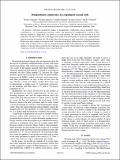Dissipationless conductance in a topological coaxial cable
Author(s)
Schuster, Thomas; Iadecola, Thomas; Chamon, Claudio; Pi, So-Young; Jackiw, Roman W
DownloadPhysRevB.94.115110.pdf (260.9Kb)
PUBLISHER_POLICY
Publisher Policy
Article is made available in accordance with the publisher's policy and may be subject to US copyright law. Please refer to the publisher's site for terms of use.
Terms of use
Metadata
Show full item recordAbstract
We present a dynamical mechanism leading to dissipationless conductance, whose quantized value is controllable in a (3+1)-dimensional electronic system. The mechanism is exemplified by a theory of Weyl fermions coupled to a Higgs field, also known as an axion insulator. We show that the insertion of an axial gauge flux can induce vortex lines in the Higgs field, similar to the development of vortices in a superconductor upon the insertion of magnetic flux. We further show that the necessary axial gauge flux can be generated using Rashba spin-orbit coupling or a magnetic field. Vortex lines in the Higgs field are known to bind chiral fermionic modes, each of which serves as a one-way channel for electric charge with conductance e²/h. Combining these elements, we present a physical picture, the “topological coaxial cable,” illustrating how the value of the quantized conductance could be controlled in such an axion insulator.
Date issued
2016-09Department
Massachusetts Institute of Technology. Department of PhysicsJournal
Physical Review B
Publisher
American Physical Society
Citation
Schuster, Thomas; Iadecola, Thomas; Chamon, Claudio et al. "Dissipationless conductance in a topological coaxial cable." Physical Review B 94, 115110 (September 2016) : 1-5 © 2016 American Physical Society
Version: Final published version
ISSN
2469-9950
2469-9969